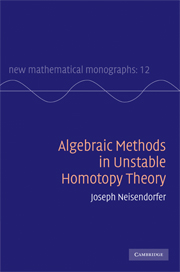Book contents
- Frontmatter
- Contents
- Preface
- Acknowledgments
- Introduction to unstable homotopy theory
- 1 Homotopy groups with coefficients
- 2 A general theory of localization
- 3 Fibre extensions of squares and the Peterson–Stein formula
- 4 Hilton–Hopf invariants and the EHP sequence
- 5 James–Hopf invariants and Toda–Hopf invariants
- 6 Samelson products
- 7 Bockstein spectral sequences
- 8 Lie algebras and universal enveloping algebras
- 9 Applications of graded Lie algebras
- 10 Differential homological algebra
- 11 Odd primary exponent theorems
- 12 Differential homological algebra of classifying spaces
- Bibliography
- Index
Introduction to unstable homotopy theory
Published online by Cambridge University Press: 03 May 2010
- Frontmatter
- Contents
- Preface
- Acknowledgments
- Introduction to unstable homotopy theory
- 1 Homotopy groups with coefficients
- 2 A general theory of localization
- 3 Fibre extensions of squares and the Peterson–Stein formula
- 4 Hilton–Hopf invariants and the EHP sequence
- 5 James–Hopf invariants and Toda–Hopf invariants
- 6 Samelson products
- 7 Bockstein spectral sequences
- 8 Lie algebras and universal enveloping algebras
- 9 Applications of graded Lie algebras
- 10 Differential homological algebra
- 11 Odd primary exponent theorems
- 12 Differential homological algebra of classifying spaces
- Bibliography
- Index
Summary
Computation of the homotopy groups πn(X) of a topological space X has played a central role in homotopy theory. And knowledge of these homotopy groups has inherent use and interest. Furthermore, the development of techniques to compute these groups has proven useful in many other contexts.
The study of homotopy groups falls into three parts.
First, there is the computation of specific homotopy groups πn(X) of spaces. This may be traced back to Poincaré [106] in the case n = 1:
Poincaré: π1(X)/[π1(X), π1(X)] is isomorphic to H1(X).
Hurewicz [62] showed that, in the simply connected case, the Hurewicz homomorphism provides an isomorphism of the first nonzero πn(X) with the homology group Hn(X) with n ≥ 1:
Hurewicz: If X is an n − 1 connected space with n ≥ 2, then πn(X) is isomorphic to Hn(X).
Hopf [58] discovered the remarkable fact that homotopy groups could be nonzero in dimensions higher than those of nonvanishing homology groups. He did this by using linking numbers but the modern way is to use the long exact sequence of the Hopf fibration sequence S1 → S3 → S2.
Hopf: π3 (S2) is isomorphic to the additive group of integers ℤ.
Computation enters the modern era with the work of Serre [116, 118] on the low dimensional homotopy groups of spheres.
- Type
- Chapter
- Information
- Algebraic Methods in Unstable Homotopy Theory , pp. 1 - 10Publisher: Cambridge University PressPrint publication year: 2010



